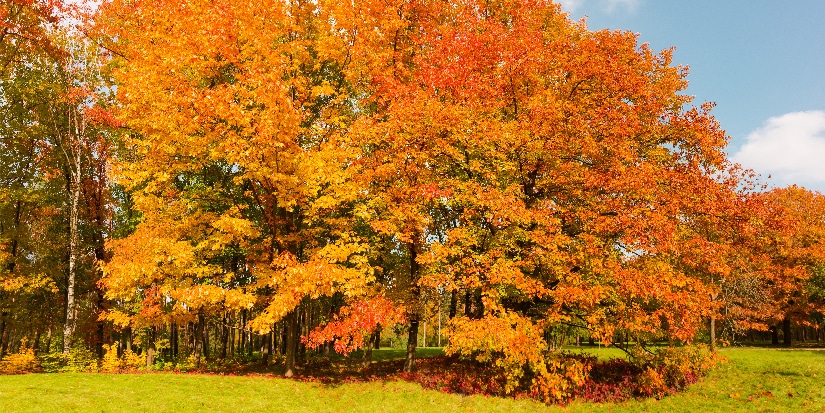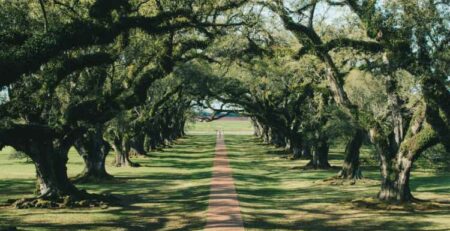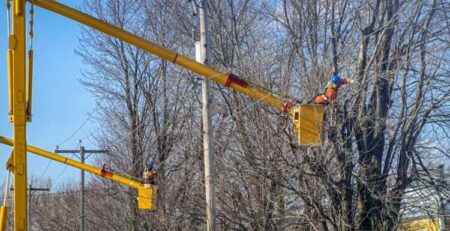The Northern Red Oak (Quercus Rubra)
Northern Red Oak is a tree known for its fast growth; hence it’s a deciduous tree. The tree is unique, and it doesn’t compare to any Red Oak class of trees. It also grows fast, and it has an open canopy which enables it to grow tall. The tree, once mature, grows to eighty feet tall hence it has glossy green foliage.
The trees have a great colour during summer hence it turns to red foliage during the season. The foliage is an excellent source of food for wildlife and squirrels. The trees have a bark that develops into ridges and darkens over time.
The best thing about the Northern Red Oak tree is its uniqueness because there are just two common Oak tree species. It is commonly grown in the Midwest, and it’s used here mostly for timber industries.
The tree also has durable wood, which is beneficial to residents of these regions. The wood of the Northern Red Oak is excellent for making furniture. The tree is great because it’s a unique species globally.

Hardiness Zone
The Northern Red Oak is a quite tolerant species to urban weather conditions, powerful winds. It can be expected to grow in hardiness zones of 3-8. The canopy of the trees looks excellent when the heavy winds are blowing. The tree does well in these hardy zones with an excellent soil variety, and its main use is for landscaping purposes.
The tree is quite marketable as it ranges in stock at a price of more than one hundred dollars. That’s why most people are growing this species in their farms up to date.
This tree is also native to North American regions, and it has been in existence for more than three hundred years. The tree is loveable due to its height limit of up to thirty meters, and its trunk grows to a diameter of 120 cm in hardy zones. The tree does well in moderate to ideal rugged conditions, and it grows without competition in these zones.
The Northern Red Oak tree’s bark can also grow from smooth grey to light grey with shallow groves in hardy zones. The tree does significantly well in the zones of optimum sunlight and the ones with shade.
This tree is adaptable to the hardy zones because of the soil condition in dry zones. Generally, it’s a tree species that can preferably prosper in loose acidic soils, which are quite loose and slightly acidic. The tree does well in the winter seasons in the hardy zones.

Type of Tree
You may be wondering which type of tree is the Red Oak, but here is an accurate description! This tree grows straight and tall to a height of 25 metres which is equivalent to eighty-two feet. The tree has a trunk that can grow up to a diameter of one hundred centimetres. Identifying Northern Red Oak’s can be hard somethings, but here are some methods to help you identify trees better.
The tree is open-grown, and it can develop a stouter trunk that grows to a diameter of two metres. The branches also grow at a right angle towards the stem, and it forms around and narrows the top head. These trees also grow rapidly, and they tolerate varied soil situations. The trees prefer well-drained soils with glacial drifts. They are frequently a part of the canopy of Oak forests, and that’s why they are unique.
This tree can do well in optimal conditions, especially in sunny regions. Statistically, this tree lives up to a period of three hundred years. You can easily recognize this tree species by observing its bark because it has ridges with shining stripes from the center going downwards.
The tree also stands out in comparison to other trees with the same appearance. You can characterize the Northern Red Oak tree by the shiny striping which goes down to its trunk. The tree is relatively abundant in European settlements of North America. The species also is getting slowly replaced by white Oaks, but it’s taking the lead.
The tree has leaflets that occur during spring, and it takes place during normal air temperatures. This species does well in cool regions, and it loses flowers during the late spring seasons.
The tree doesn’t have a seed crop, and its leaves emerge during this season. This Northern Red Oak tree species has two growing seasons and releases its leaves early in October, where it drops leaves. The best time for leaf drops and leaf outs varies in weeks for Northern Red Oak trees.
The bark of this tree is dark red to gray-brown, and it has a broad, thin ridge that is scaly. When still young, the trees have smooth stems that are light gray, and they have lots of tannins. The tree branches are relatively slender and bright green at first; as the seasons change, they turn dark red then dark brown.

The wood of Northern Red Oak trees is pale red-brown, and its sapwood gets darker, hard, heavy coarse-grained, and strong. The wood is best for furniture due to this factor. That’s why it’s mostly used in interior finishes for houses or general constructions. The timber is quite marketable, especially in urban regions.
The Northern Red Oak tree’s winter buds have a red-brown colour, and they are up to six mm long.
The tree has excellent leaves that can grow up to six inches broad, and they form broad bases with bristles. The leaves bristles have pointed teeth, and they are quite large. The leaves of Northern Red Oak trees emerge from pink buds covered with a soft silky coat.
These trees also have a dark green smooth shine after they mature. The trees have shiny yellowish-green and smooth hairs on the axils of the veins of the tree. The tree turns dark red during autumn, and they can also turn brown. This tree’s petiole has mid-red veins with rich red colour, and its acorns can mature a year after pollinating.
The tree has an acute apex that can grow up to a length of one inch. The tree first matures as it turns green, and its base can turn red-brown as the tree grows. This tree’s acorns display a dormancy; hence, they do not germinate until three months are over. The trees need exposure to a temperature of fewer than four degrees. The trees also take up to two years to grow and develop ultimately.
Full Size
This species of Northern Red Oak trees thrive in cities and forests when they have enough space. The tree can grow to the full size of up to two feet yearly. The tree has acorns which are food for animals like wild turkeys, deer, bears, raccoons, and blue jays. Statistically, this tree has the potential to live up to five hundred years, and it stays healthy for 150 years.
As temperatures rise, the species climbs and gives colourful shade, which is the canopy. The trees look amazing during bright weather.

Growth Rate
These trees have dense leaf foliage, which gives them good coverage, and they can grow to a height of up to one hundred feet. Among all the trees in the mid-west, this species is known to have the best shade, especially during the sunny afternoons.
Northern Red Oak trees are native to Canadian countries, and distinctive leaves, acorns, and leaves mostly characterize the tree. The trees, after reaching maturity they turn dark brown, especially on the ridges. The tree has excellent leaves that are lustrous green and appear dark green on both sides. The tree’s acorns can grow up to three cms, and they have a red-brown cup on one side.
The leaves of this tree have a lustrous dark colour which has sharp lobes. The acorns of the tree stay on throughout the winter seasons, unlike the White Oak species.
You should plant this tree’s seedlings in an open area due to their light requirements, which should be thirty percent. This light intensity helps in these seeds’ growth, but small sprouting trees should be in a planting space of up to nine square metres. Many tree programs can give you all the interesting facts about planting your Northern Red Oak trees. The trees thrive in optimum conditions, and that’s why they are common in regions like Cleveland Park, Logan, woodland Norman Stone, etc.

Sun Preference
This tree’s species do well in optimum conditions, and the leaves only get affected during the fall season when they turn red. These leaves usually have some waxy lobes. The tree is a known Street tree that tolerates pollution and compacted soils; hence optimum sunlight is favourable to the species. The trees need light because they can grow up to two feet in a year.
The tree also grows to a height of up to 82 feet, and this spreads after maturity. The species has a fast growth speed, and the size also increases yearly.
The species does well in full sun conditions, which means the direct sun is required for up to six hours daily. The concentrated sunlight should be unfiltered and natural; hence it is the best sun preference. If you want to see positive results in your Oak tree, you should ensure the tree has access to direct sunlight in your growing zone.
That’s why this tree is known to be drought-tolerant, and it does well in optimum weather conditions. This tree species’ positive attributes are how it can grow up to three feet yearly, and it provides a fantastic colour during the fall season.
The trees also have leaves that turn russet red during some seasons. The trees have good seedlings which have ease of transplanting. They also offer a good shade for wildlife, especially during the summer seasons.
These seasons are quite hot; hence you will see animals under the canopies or the Northern Red Oak trees. The dense crowns of these trees give them a good shade, mainly due to their round shape. These trees grow to form round shapes, which make their canopies lovely. That’s what attracts most tourists in regions with these trees.
Soil Preference
This tree perfectly grows in acidic, moist, loamy, well-drained, sandy, and clay soils. While Red Oak prefers regular moisture, this tree has some drought tolerance.

Attributes of a Northern Red Oak
Here are some interesting attributes of this tree:
- It usually grows more than 2 feet each year for almost ten years.
- The Red Oak tree exhibits an extremely lovely fall colour, with leaves beautifully turning russet-red to vibrant bright red colour.
- It possesses a dense crown and so acts as the best shade option.
- Red Oak mainly grows in a typical round shape.
- This species is much easier and comfortable to transplant than many others.
- It has the power to tolerate pollution and compacted soil.
- This tree produces pale yellow-green catkins, which can be observed mostly in April-May, while foliage expands.
- This tree also features alternating leaves that are almost 4–8″ long and have 7–11 waxy, spine-tipped lobes.
- It yields acorns that are round and ¾–1″ long with a flat, dense, saucer-like cap.
Wildlife Value of Northern Red Oak Trees
The Northern Red Oak trees’ acorns make good food for most wildlife like wild turkeys and raccoons. Deer also enjoy the twigs on the North Oak tree during the winter.

The History of Northern Red Oak Trees
Among all the trees that go down in history, the Northern Red Oak has been in existence for more than four hundred years. These trees have been the favourites for landscapers ever since the colonial days.
These trees have been favourable after transplantation. The first tree species was received in England on the Bishop Campton’s Gardens. The garden is near Fulham, and that’s where the first Northern Red Oak was planted.
Since then, this tree has been transplanted to various regions, and it has been spreading since the seventeenth century. By the early 1920s, the Northern Red Oak had been in more than four hundred acres of German lands. Since this time, many people have been inspired to nurture, plant, and celebrate these trees’ growth.
A foundation called arbour day is a conservation program that advocated for the maintenance of these trees. The foundation was later joined and supported by many donors and partners to make the world healthier and green.

Care Tips For The Northern Red Oak Trees
Historically, the Northern Red Oak trees are among the best trees with a low maintenance requirement, they are long-lived, and that’s why many people consider planting them.
- The trees do well in many soil types, especially well-drained soils. The trees do well in moist, neutral, and acidic soils.
- As long as the soil has a pH of more than seven, this species of trees will not do well, showing signs of iron deficiency.
- These soils with such signs may have yellow leaves, making it difficult to treat or rectify the situation.
- Treating this species is hard; hence the health of your trees may deteriorate. Alkaline soils aren’t favourable for this tree species; therefore, you should try other trees’ landscaping species.
You should water your Northern Red Oak regularly if you want positive results. The trees need thorough watering, especially during the first seasons when the tree’s roots become established. The old trees do not require any supplemental irrigation, but you can implement this dry season strategy.
You should be very cautious with the Oak tree during planting seasons, and you should avoid using fertilizer. It’s advisable to use a small number of all-purpose fertilizers throughout the spring seasons. Keep in mind that these trees don’t need excess fertilizer, and you should be cautious if you have planted them in the fertile lawn area.
It’s advisable to prune your Northern Red Oak tree and remove any diseased or dead branches or limbs. This removal should happen on brunches or limbs which grow vertically, rubbing themselves against each other. You should cut these branches on the collar zones, which are the small bumps between branches and trunks.
You should not use any wrappings or ointments, and you should prune when the tree is still young. Whenever you plan to prune your Northern Red Oak tree, you should hire experts to avoid damaging the tree. This step is advisable to ensure the branches remain in good condition.
Which Pests And Diseases Attack The Northern Red Oak?
Like any other tree species, these trees are susceptible to many diseases, insects, and pests. The variety of the pests which attack the tree are not that serious. There are many ways of managing your tree from disease infestation.
The common disease is powdery mildew or leaf spot; hence you should keep the tree healthy by watering regularly. With good pruning services, this tree species don’t get infected by severe diseases or pests. Some pests like leafhoppers or caterpillars can infest your Northern Red Oak, but you can use birds that feed on these pests to help control them.

The other thing which commonly infects this species of trees is the cankers which are caused by fungus. You may characterize the disease by white and brown growths on the bark of the tree. That’s why it’s advisable to pull all the infected branches from the tree and disinfect these pruning tools.
You can disinfect them by dipping them in a chlorine bleach solution for ten minutes. You shouldn’t let the cankers get inside the tree trunk as this will destroy the tree.
The Oak wilt is also a severe fungal disease that Northern Red Oak trees are susceptible to, and it’s controllable. This disease affects the tree in the leaves whereby the tree leaves are lost at the top, and eventually, the lower leaves drop and die.
Brown streaks characterize the wood’s infection; hence you should seek advice from tree specialists if your tree has these signs. The primary remedy for this disease is to cut the tree to avoid spreading the disease to the nearby trees.
Uses Of The Northern Red Oak
- The Northern Red Oak trees have many uses, and they are quite beneficial to both human beings and animals. The wildlife depends on this tree for food, especially deers that feed on the tree’s twigs and branches.
- The industrial use of the Northern Red Oak is in the hardwood industry. Many companies use this species as a source of hardwood lumber. This tree’s wood is suitable because it is close-grained; hence, Heavy machines accept this breed due to its finish. The wood uses to make furniture like interior finishes, cabinets, beds, and it’s used for flooring purposes.
- Most agricultural posts and implements like railway tiles are used using this species.
- The Northern Red Oak is also beneficial to wildlife, mostly in the rainforests with this tree.
- The tree provides a great cover and good resting places for nesting for mammals and birds. Many birds, rabbits, elk, and mice feed in the leaves, seedlings, and acorns of the tree. The trees are beneficial to large herds of wildlife, especially the herbivores.
- People in ancient times used to eat the acorns of the Northern Red Oak. These are the ethnobotanical benefits of this tree species. Native Americans in the nineteenth century used to eat the acorns of this tree. The only bitter part of the tree was the tannin, and it would be removed by boiling and leaching with ashes and soaking it for days. They would also be buried during the winter seasons.
- Many tribes found out the Northern Red Oak has medicinal value; hence they used the tree’s bark to cure heart troubles. The tree also cute bronchial infections, and it could also be used as a cleanser, disinfectant, and astringent.
- The conservation uses of the Northern Red Oak tree are for landscaping purposes. The tree commonly uses in North America and Europe as a lawn shade. It’s also used mostly in parks, especially America and golf courses. Rich people also use the tree for landscaping their fields, and Mexicans also use the tree in their haciendas.
- The tree is fast-growing, and it is easy to transplant from a seedbed to your lawn. If you are looking for the best way to landscape your property, you should choose this tree species.

Final Thoughts On The Northern Red Oak
If you are looking for the best way to landscape your lawn or golf course, you should choose the Northern Red Oak.
The trees are quite tolerant to adverse conditions, especially acidic and dry soils. The trees mostly attract lots of wildlife, and these trees have leaves that develop a red colour during fall seasons. The tree species is historically used in rehabilitation projects, and it is commonly used in the revegetation of some spoilt coal mines in Ohio, Illinois, and Indiana.







